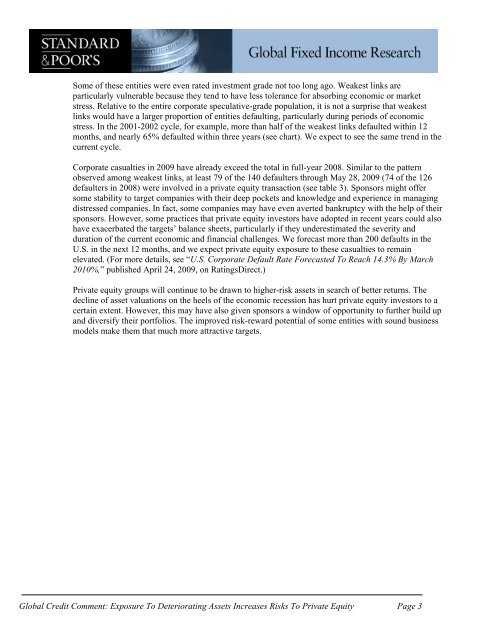gcc_pe_wl-d
gcc_pe_wl-d
gcc_pe_wl-d
Create successful ePaper yourself
Turn your PDF publications into a flip-book with our unique Google optimized e-Paper software.
Some of these entities were even rated investment grade not too long ago. Weakest links are<br />
particularly vulnerable because they tend to have less tolerance for absorbing economic or market<br />
stress. Relative to the entire corporate s<strong>pe</strong>culative-grade population, it is not a surprise that weakest<br />
links would have a larger proportion of entities defaulting, particularly during <strong>pe</strong>riods of economic<br />
stress. In the 2001-2002 cycle, for example, more than half of the weakest links defaulted within 12<br />
months, and nearly 65% defaulted within three years (see chart). We ex<strong>pe</strong>ct to see the same trend in the<br />
current cycle.<br />
Corporate casualties in 2009 have already exceed the total in full-year 2008. Similar to the pattern<br />
observed among weakest links, at least 79 of the 140 defaulters through May 28, 2009 (74 of the 126<br />
defaulters in 2008) were involved in a private equity transaction (see table 3). Sponsors might offer<br />
some stability to target companies with their deep pockets and kno<strong>wl</strong>edge and ex<strong>pe</strong>rience in managing<br />
distressed companies. In fact, some companies may have even averted bankruptcy with the help of their<br />
sponsors. However, some practices that private equity investors have adopted in recent years could also<br />
have exacerbated the targets’ balance sheets, particularly if they underestimated the severity and<br />
duration of the current economic and financial challenges. We forecast more than 200 defaults in the<br />
U.S. in the next 12 months, and we ex<strong>pe</strong>ct private equity exposure to these casualties to remain<br />
elevated. (For more details, see “U.S. Corporate Default Rate Forecasted To Reach 14.3% By March<br />
2010%,” published April 24, 2009, on RatingsDirect.)<br />
Private equity groups will continue to be drawn to higher-risk assets in search of better returns. The<br />
decline of asset valuations on the heels of the economic recession has hurt private equity investors to a<br />
certain extent. However, this may have also given sponsors a window of opportunity to further build up<br />
and diversify their portfolios. The improved risk-reward potential of some entities with sound business<br />
models make them that much more attractive targets.<br />
Global Credit Comment: Exposure To Deteriorating Assets Increases Risks To Private Equity Page 3


